

The first time I went to Edinburgh, I felt like stepping into a storybook, where every cobbled lane, smoky pub, and castle view feels like part of a centuries-old tale still being written. And I can say this feeling doesn’t go away. One moment you’re walking past a centuries-old castle, and the next, you’re grabbing a flat white in a café filled with students and freelancers.
It’s beautiful, walkable, and surprisingly easy to call home. Some find their place in a Georgian flat in New Town, others in a snug apartment near the Meadows or a sea-view home in Leith.
Finding a place to live in Edinburgh is all about balancing history and convenience. The city is compact and walkable, divided between the atmospheric Old Town and the elegant Georgian streets of the New Town.
Rent varies depending on the area. Central neighbourhoods like Old Town and New Town are the priciest, while Leith, Marchmont, and Stockbridge offer more space and local flavour. Many apartments are furnished and include essentials, but heating and council tax can significantly impact monthly costs.
This is the heart of Edinburgh’s history and architecture. Living here means being surrounded by landmarks, cafés, and cobbled charm, but at a premium price. Ideal for professionals and expats who want to live close to the action.

Trendy and cosmopolitan, Leith has transformed from a port district into one of Edinburgh’s most vibrant areas. Expect converted warehouses, modern flats, and a thriving food and arts scene.
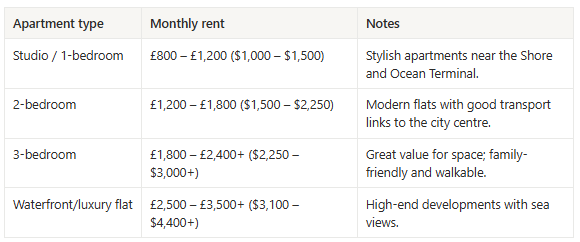
Leafy, laid-back, and full of students and young professionals. These areas are close to the University of Edinburgh and the Meadows, offering a community feel without being far from the city centre.
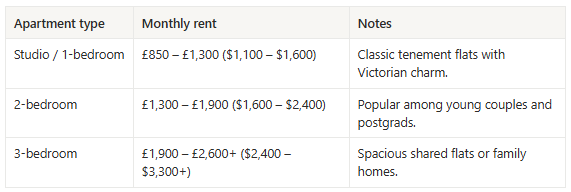
Two of the most desirable residential areas in Edinburgh, Morningside and Stockbridge are green, family-friendly, and packed with independent shops and cafés. Ideal for families, long-term expats, and anyone seeking quiet luxury.
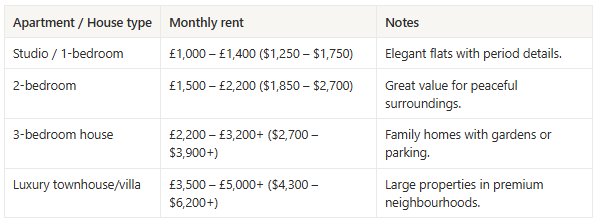
Getting around Edinburgh is one of the city’s simple pleasures. Compact, scenic, and well connected, it’s the kind of place where you can walk almost anywhere. Public transport is reliable, cycling is growing in popularity, and the tram makes getting to the airport a breeze.
Buses
Lothian Buses are the backbone of Edinburgh’s transport system. They’re clean, frequent, and cover nearly every corner of the city, from the city centre to seaside suburbs like Portobello.
Trams
The Edinburgh Trams connect the airport to the city centre, passing through key areas like Haymarket, Princes Street, and St Andrew Square. The line now extends north to Leith, making it an efficient way to reach the waterfront.
Trains
Trains are ideal for exploring Scotland beyond the capital. Edinburgh Waverley and Haymarket are the main stations, with regular services to Glasgow, Dundee, Inverness, and London.
Taxis
Black cabs are easy to find in the city centre and near major attractions. They’re metered, spacious, and driven by knowledgeable locals. Private-hire cabs (booked via apps) are slightly cheaper.
Ride-hailing apps (Uber, Free Now)
Ride-hailing services are popular for convenience, especially late at night or when carrying luggage. Prices are typically a little higher than taxis during peak times but still affordable for short trips.
Cycling
Edinburgh’s cycling network has grown in recent years, with dedicated lanes across the city and scenic routes through parks and canals. Many locals use bikes for daily commutes or weekend rides.
Walking
Walking is arguably the best way to experience Edinburgh. The city is compact, beautifully designed, and full of views — from the cobbles of the Royal Mile to the slopes of Arthur’s Seat.
Driving/Car rentals
Driving isn’t usually necessary unless you’re exploring the Highlands or nearby towns. Parking can be tricky and expensive in the centre, but roads are smooth and scenic outside the city.
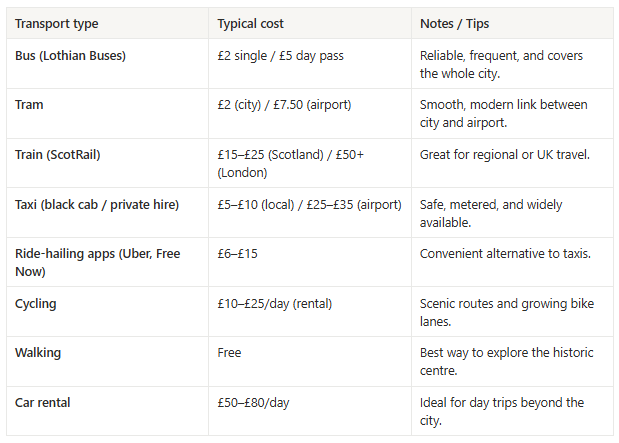
Edinburgh’s food scene is as rich as its history, where hearty Scottish classics meet global influences. From cosy pubs serving haggis, neeps and tatties to street markets selling artisan pastries, and elegant restaurants offering modern Scottish cuisine, eating in Edinburgh is as much about atmosphere as flavour.
Restaurants
Dining out in Edinburgh ranges from affordable café meals to Michelin-starred experiences. You can grab a bowl of soup and a sandwich for a few pounds or enjoy a three-course meal with a castle view. It all depends on your mood (and budget).
Cafés and bakeries are part of Edinburgh’s charm — perfect for lazy mornings or afternoon breaks. A latte and pastry usually costs around £5–£8 ($6–$10), and you’ll find everything from traditional shortbread to flaky French croissants.
Supermarkets and markets
Grocery prices in Edinburgh vary depending on where you shop. Large supermarkets offer convenience and variety, while local markets and smaller greengrocers are great for fresh produce and artisanal goods.

Cooking at home is generally more affordable than eating out, and most expats find a balance between supermarket shopping and enjoying Edinburgh’s lively restaurant and café culture.
For one person
Total monthly food budget: $480–800
Comfortable enough to cook at home most days and enjoy a few nights out at pubs or restaurants each week.
For a couple or small family
Total monthly food budget: $900–1,400
That allows for home-cooked meals, weekend brunches, and the occasional treat at one of Edinburgh’s many excellent bistros, gastropubs, or fine dining spots.
Living in Edinburgh comes with moderate utility costs compared to other major UK cities. Heating is the biggest factor, especially during the colder months, but good insulation and energy-efficient appliances can help keep bills under control. Most flats include basic appliances, and payments are made monthly through providers or direct debit.
Electricity and gas
Electricity and gas bills tend to rise in winter due to heating use. Most homes rely on a dual-fuel plan, which combines both utilities under one provider for convenience.
Water
Water services in Scotland are handled by Scottish Water and are typically included in your Council Tax, meaning most residents don’t receive a separate bill. For larger homes or private arrangements, small quarterly charges may apply.
Internet
Edinburgh offers reliable and fast broadband, with fibre connections widely available. Speeds are generally strong enough for streaming, remote work, and online meetings.
Mobile/phone plans
Mobile data and phone plans are affordable, with flexible pay-as-you-go or monthly options.
TV licence and streaming
If you watch live television or use BBC iPlayer, you’ll need a TV licence. Streaming services like Netflix, Disney+, and Amazon Prime are optional extras.
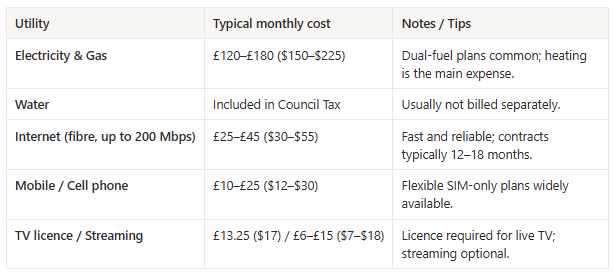
Healthcare in Edinburgh is among the best in the UK, offering residents access to high-quality public care through the National Health Service (NHS) as well as private options for those seeking faster appointments or specialised treatment. For expats, the system is straightforward once you’re registered, and most day-to-day medical needs are covered at little or no cost.
Public healthcare (NHS Scotland)
Scotland’s public healthcare system is funded by taxes and provides comprehensive services, from GP (general practitioner) consultations to hospital treatment and emergency care. Once registered with a local GP practice, you can access NHS services free of charge.
Expats living or working in the UK for more than six months are eligible for NHS access through the Immigration Health Surcharge (IHS) paid during their visa application. Short-term visitors or digital nomads can use private clinics or travel insurance instead.
Private healthcare and insurance
Private healthcare in Edinburgh is a great option for those who prefer shorter waiting times or access to specific specialists. The city has several reputable private hospitals and clinics, offering everything from dental work to physiotherapy and elective surgery.
Private health insurance is optional but useful for expats and professionals who prefer flexibility. It can cover faster GP appointments, private hospitals, and elective procedures not included in the NHS.

Edinburgh offers a high quality of life wrapped in history, charm, and culture. It’s more affordable than London but still one of the pricier cities in the UK, especially when it comes to rent and winter utilities. That said, it’s entirely possible to live comfortably here with a balanced lifestyle, good budgeting, and a few local habits like shopping at farmers’ markets and using public transport.
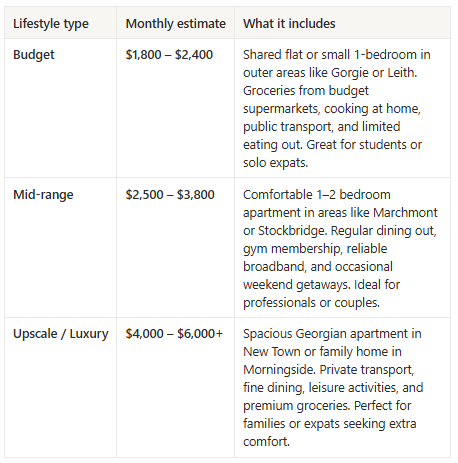
You can live well in Edinburgh on around $2,500–$3,000 per month, depending on your lifestyle. While housing and heating can stretch your budget, affordable public healthcare, free education, and walkable neighbourhoods help balance the cost of living.
From cobblestone streets to castle views, life in Edinburgh is full of experiences worth savouring. To truly enjoy living in this storybook city, managing your international finances should be simple and stress-free, especially if you earn or receive payments from abroad.
With Grey, you can receive payments in USD, GBP, or EUR, hold multiple currencies, convert when the rates are best, and withdraw directly to your UK bank account. It’s quick, secure, and designed for people living and working across borders.
Open a free Grey account and keep your focus on the story you’re living, not the transfers behind it.




.svg)
Back to top